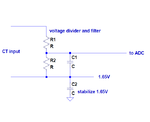archusvijay1
Member level 3
Hi,
I am trying to measure AC rms voltage using PIC microcontroller. I have attached the circuit for measurement. I am connecting a 3V step down transformer out to the input of the circuit.The feedback capacitor has been added to reduce the noise, but I am getting noise if I add this. This is getting smooth after the low pass filtering. Everything else, like clamping the voltage and all are properly happening. Do I really need to place the feedback capacitor? What are the recommended values if it is needed?
Thanks
I am trying to measure AC rms voltage using PIC microcontroller. I have attached the circuit for measurement. I am connecting a 3V step down transformer out to the input of the circuit.The feedback capacitor has been added to reduce the noise, but I am getting noise if I add this. This is getting smooth after the low pass filtering. Everything else, like clamping the voltage and all are properly happening. Do I really need to place the feedback capacitor? What are the recommended values if it is needed?
Thanks

